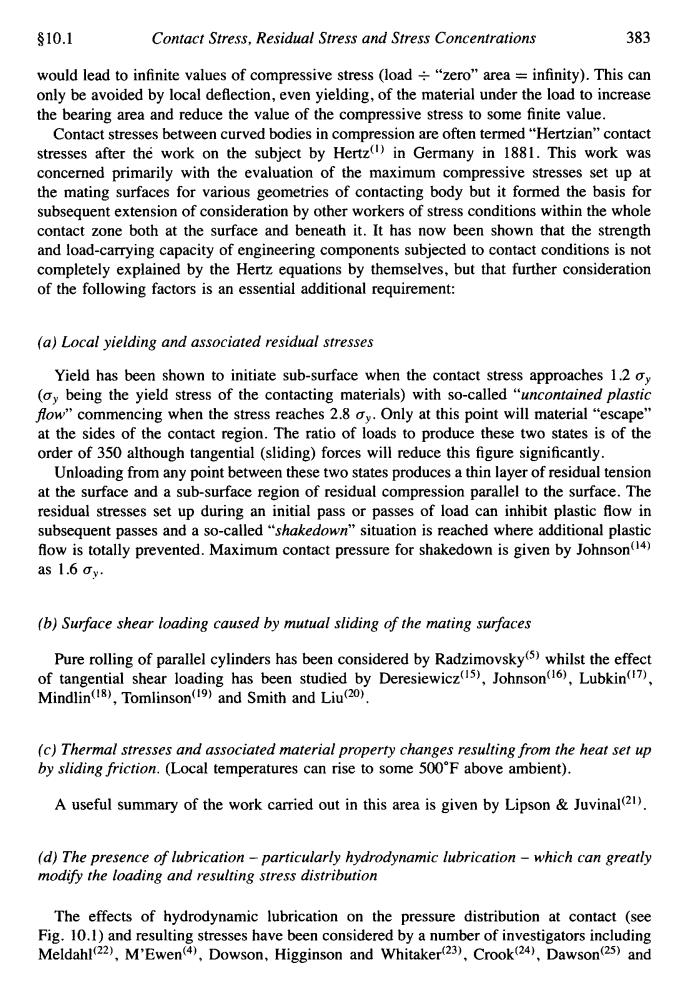正在加载图片...

§10.1 Contact Stress,Residual Stress and Stress Concentrations 383 would lead to infinite values of compressive stress (load -"zero"area infinity).This can only be avoided by local deflection,even yielding,of the material under the load to increase the bearing area and reduce the value of the compressive stress to some finite value. Contact stresses between curved bodies in compression are often termed"Hertzian"contact stresses after the work on the subject by Hertz()in Germany in 1881.This work was concerned primarily with the evaluation of the maximum compressive stresses set up at the mating surfaces for various geometries of contacting body but it formed the basis for subsequent extension of consideration by other workers of stress conditions within the whole contact zone both at the surface and beneath it.It has now been shown that the strength and load-carrying capacity of engineering components subjected to contact conditions is not completely explained by the Hertz equations by themselves,but that further consideration of the following factors is an essential additional requirement: (a)Local yielding and associated residual stresses Yield has been shown to initiate sub-surface when the contact stress approaches 1.2 oy (oy being the yield stress of the contacting materials)with so-called "uncontained plastic fow"commencing when the stress reaches 2.8 oy.Only at this point will material "escape" at the sides of the contact region.The ratio of loads to produce these two states is of the order of 350 although tangential(sliding)forces will reduce this figure significantly. Unloading from any point between these two states produces a thin layer of residual tension at the surface and a sub-surface region of residual compression parallel to the surface.The residual stresses set up during an initial pass or passes of load can inhibit plastic flow in subsequent passes and a so-called"shakedown"situation is reached where additional plastic flow is totally prevented.Maximum contact pressure for shakedown is given by Johnson(14) as 1.6 oy. (b)Surface shear loading caused by mutual sliding of the mating surfaces Pure rolling of parallel cylinders has been considered by Radzimovsky(5)whilst the effect of tangential shear loading has been studied by Deresiewicz(15),Johnson(16),Lubkin(7) Mindlin(18),Tomlinson(19)and Smith and Liu(20). (c)Thermal stresses and associated material property changes resulting from the heat set up by sliding friction.(Local temperatures can rise to some 500F above ambient). A useful summary of the work carried out in this area is given by Lipson Juvinal(21). (d)The presence of lubrication-particularly hydrodynamic lubrication-which can greatly modify the loading and resulting stress distribution The effects of hydrodynamic lubrication on the pressure distribution at contact (see Fig.10.1)and resulting stresses have been considered by a number of investigators including Meldahl(22),M'Ewen(4),Dowson,Higginson and Whitaker(23),Crook(24),Dawson(25)and$10.1 Contact Stress, Residual Stress and Stress Concentrations 383 would lead to infinite values of compressive stress (load t “zero” area = infinity). This can only be avoided by local deflection, even yielding, of the material under the load to increase the bearing area and reduce the value of the compressive stress to some finite value. Contact stresses between curved bodies in compression are often termed “Hertzian” contact stresses after the work on the subject by Hertz(’) in Germany in 1881. This work was concerned primarily with the evaluation of the maximum compressive stresses set up at the mating surfaces for various geometries of contacting body but it formed the basis for subsequent extension of consideration by other workers of stress conditions within the whole contact zone both at the surface and beneath it. It has now been shown that the strength and load-carrying capacity of engineering components subjected to contact conditions is not completely explained by the Hertz equations by themselves, but that further consideration of the following factors is an essential additional requirement: (a) Local yielding and associated residual stresses Yield has been shown to initiate sub-surface when the contact stress approaches 1.2 ay (ay being the yield stress of the contacting materials) with so-called “uncontained plastic flow” commencing when the stress reaches 2.8 cy. Only at this point will material “escape” at the sides of the contact region. The ratio of loads to produce these two states is of the order of 350 although tangential (sliding) forces will reduce this figure significantly. Unloading from any point between these two states produces a thin layer of residual tension at the surface and a sub-surface region of residual compression parallel to the surface. The residual stresses set up during an initial pass or passes of load can inhibit plastic flow in subsequent passes and a so-called “shakedown” situation is reached where additional plastic flow is totally prevented. Maximum contact pressure for shakedown is given by Johnson(14) as 1.6 a,,. (b) Sugace shear loading caused by mutual sliding of the mating surfaces Pure rolling of parallel cylinders has been considered by Radzimo~sky(~) whilst the effect of tangential shear loading has been studied by Deresie~icz(’~), Johnson(16), Lubkid”) , Mindlin(’*), Tomlin~on(’~) and Smith and Lid2’). (c) Thermal stresses and associated material property changes resulting from the heat set up by sliding friction. (Local temperatures can rise to some 500°F above ambient). A useful summary of the work carried out in this area is given by Lipson & Juvinal(2’). (d) The presence of lubrication - particularly hydrodynamic lubrication - which can greatly modify the loading and resulting stress distribution The effects of hydrodynamic lubrication on the pressure distribution at contact (see Fig. 10.1) and resulting stresses have been considered by a number of investigators including Meldah1(22), M’Ew~~(~), Dowson, Higginson and Whitaker(23), Crook(24), Da~son(~~) and